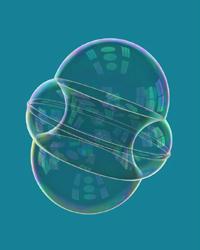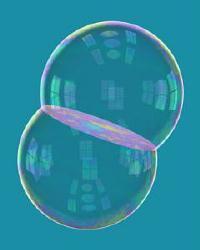Double bubbles in the air

Knowing that Pythagoras opened the door to understanding triangles, how have we not already mastered all geometry? Because we have given many valid answers without demonstrating them mathematically. It may be the most practical behavior in everyday life. But if we had to design a futuristic building, perhaps we should hire the geometrist.
We have made soap bubbles often small. We have also seen two bubbles fly at once. Both glued. One greater than the other. The pairs of bubbles that have escaped the attack of the devastating bubbles of the evil child, in flight, usually break the intermediate crust and make it a big bubble. Why?
Somehow in a bubble the soap is more comfortable than in both. Mathematically, it is because they use less surface to maintain the same volume of air. Nature is like that. Like the minimums. This has attracted the attention of scientists like mathematicians.
Models of nature
To put an end to the bigger bubble problem, only basic calculations are needed. But they began to look for the explanation of the shape of the two bubbles stuck by the geometrists. That is, why are both associated with that well-known aspect? Is there no alternative? Moreover, in any case what would be the other optional aspect?

If possible. The smaller bubble could be placed around the larger as if it were a float. According to mathematical calculations, in addition, this structure could reduce its surface. If used to remove the air from the inner bubble and form a thin ring like float belt. Perhaps it is a very complex geometric shape and we know intuitively that it does not occur, but why?
Michael Hutchings, from Standford University, began to seek an answer. He discarded completely emptied rings. His second discovery only serves when the two volumes are equal (or very similar). In this case no belts are formed. Therefore, the only option is the simplest float structure.
Based on the results of this work, a team from the University of California continued the research. They found the answer to the problem of the structures of two equal volumes. Computer calculations indicated that a smaller surface than the float structure can always be achieved in any way. This result was extended and confirmed until 7:1 in the ratio between two volumes. In more unbalanced proportions the calculation was too high.
The final solution, as required by elegant mathematics, can be found with pencil and paper. Williams College mathematician Frank Morgan found an answer. The movement of drying wet clothes reduces the surface of the float structure. Therefore, this structure does not have a minimum surface. The hard thing about this method is to find the right way to fold the bubbles without modifying the volume.
All this work was done with three-dimensional bubbles that appear in nature. But a group of mathematicians from Granada generalized the method when it comes to qualifying in more dimensions. Research is also being conducted in the case of three-bubble associations. However, the problem response has not been defined in both dimensions. It is more difficult. We intuitively know the answer. Who has not managed to join three bubbles in a breath?
Buletina
Bidali zure helbide elektronikoa eta jaso asteroko buletina zure sarrera-ontzian











